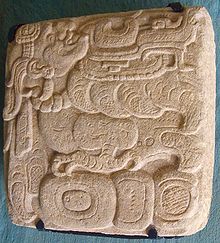

TYPE: Creator god
ORIGIN: Mayan - Classical Mesoamerican, Mexico
KNOWN PERIOD OF WORSHIP: Circa CE 300 until circa CE 900.
SYNONYMS: Hunab Ku; Hun Itzamna; Yaxcocahmut; God K.
CENTER(S) OF CULT: Chichen Itza and other sites, mainly in the Yucatan peninsula.
ART REFERENCES: Stone carvings, codex illustrations.
LITERARY SOURCES: mainly the Vienna Codex.
INFORMATION: The principal god in the Mayan pantheon according to the Vienna codex. He lives in the sky and sends the rain. Also a god of medicine and a fire god. By tradition the Maya believed that the world was set within a vast house, the walls and roof of which were formed by four huge iguanas standing upright but with their heads bent downwards. Each reptile has its own direction and color.
Itzam Na is not invoked in the rites of modern Yucatan peasants but, at one time, was the subject of a ritual which involved daubing the lowest step with blue pigment (the color peculiar to rain gods). At Chichen Itza sacrifice was regularly made to a huge crocodile believed to be the personification of the god.
Itzam Na is probably the same deity as Hunab Ku, who is identified in some texts as his father, but in the guise of a reptile. He may also be depicted anthropomorphically. In his aspect as a vegetation god, Itzam Na may be the same as the so-called God K of the Codices, recognized by a long branching nose in the form of a pair of infolded leaves. His earthly aspect is called Itzam Cab, in which guize maize leaves sprout from the top of his head.